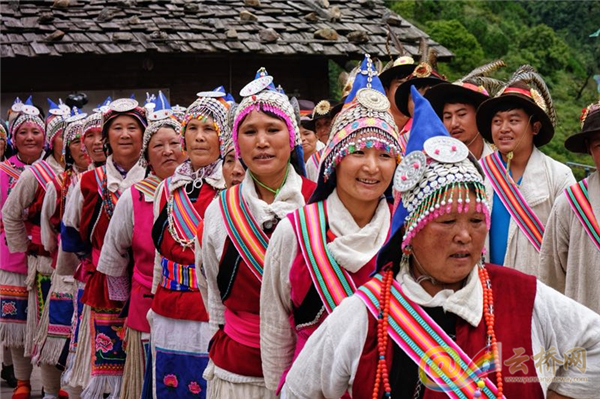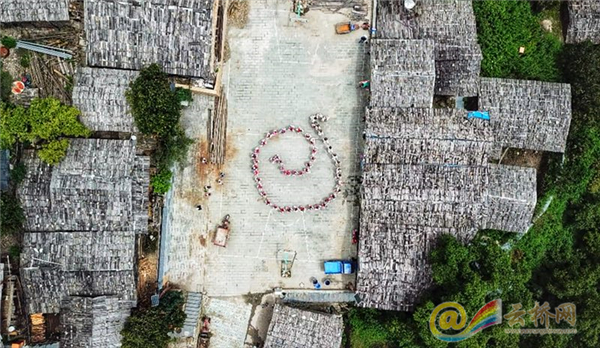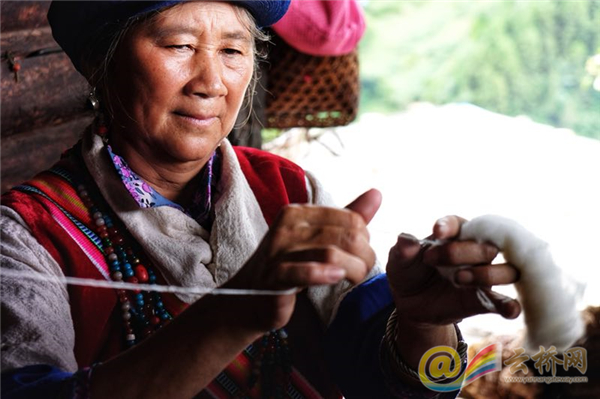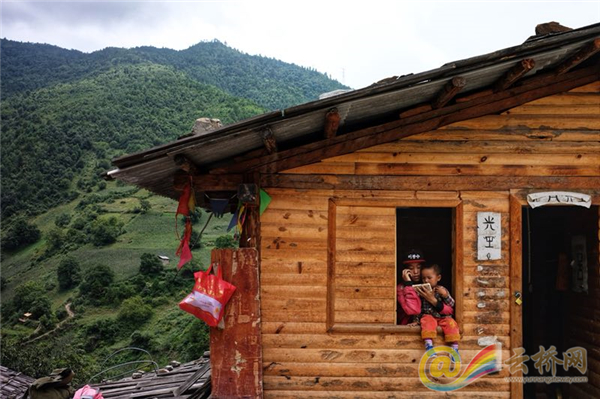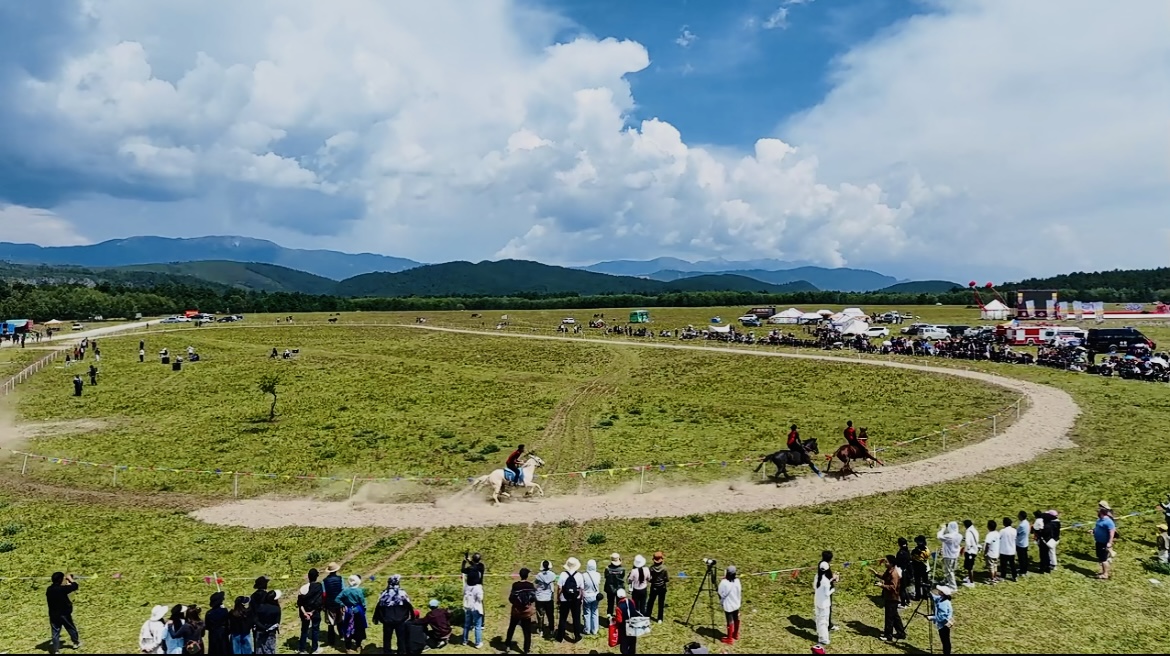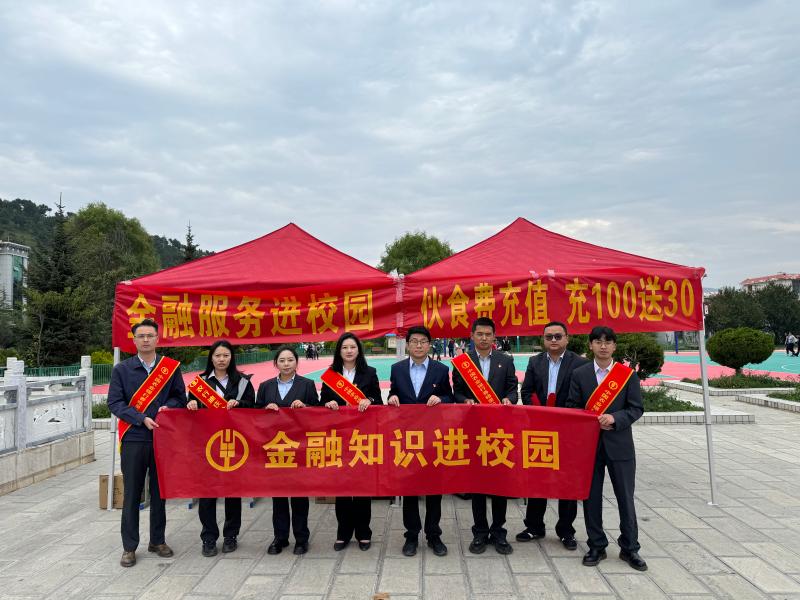|
“春节前家家户户杀年猪,为了庆祝丰收,亲朋好友要聚在一起,唱跳阿尺木刮。其中,歌词要涉及一年365天。”8月29日中午,在迪庆藏族自治州维西傈僳族自治县叶枝镇同乐村,50岁的国家级非物质文化遗产传承人李碧青带领村民们热情奔放地表演阿尺木刮,他们骄傲地介绍,“自然万物都可以进入到阿尺木刮的歌词里。” “Families here slaughter pigs before the Chinese New Year to celebrate harvest. It is also a time of reunion for relatives and friends, and they’ll sing and dance Achimugua then. The lyrics of the show should involve moments in the whole year,” said Li Biqing on Aug. 29. Along with the fellow villagers, Li Biqing, aged 50, was passionately performing Achimugua in Tongle Village of Yezhi Township, northwest Yunnan’s Weixi Lisu Autonomous County. She said proudly: “Everything can be included in lyrics of Achimugua.”
同乐,是孕育了阿尺木刮的千年古寨。站在村子对面的公路上,遥望这幅满是乡愁的画卷:蓝天白云下,最耀眼的是浓得化不开的绿色,一棵棵大树生机勃发;镶嵌其中的一栋栋褐色的傈僳族木楞房,与大树相依相偎;那些木头和石片屋顶,因为日复一日的火塘烟熏、炊烟缭绕,其色泽和质感极具历史沧桑之美;而老屋、新绿,相映生辉。 Tongle, a village with a millennium-long history, is the birth place of Achimugua. With blue sky, white cloud and green trees, it is also a livable place favored by people from outside. The brown Muleng houses, where locals live in, dotted the village. The woods and roof tiles, which are smoked day after day by fire pits, remind us the vicissitudes in history. Looked at from afar, the village is like a harmonious picture of spring verdancy and featured old dwellings.
从看见到走进,花了20分钟左右的时间,我们来到同乐。进村的道路上,路灯装饰成傈僳族喜欢的烟斗形状,有点像外国童话故事里魔法师的帽子,别出心裁。知道我们来做客,李碧青带着同伴们到村口迎接。初秋午后的阳光下,清风和着阿尺木刮的歌声、舞步传递出快乐的心情。 It took us 20 minutes to get to the village. We noticed that the street lamps were decorated by tobacco pipe-shaped patterns favored by Lisu people. The decorations also look like the hats of magicians in fairy tales. Noting we were here to visit, Li Biqing welcomed us at the entrance of the village together with her fellows. Joyful singing and dancing of Achimugua came to our ears, and the feeling of happiness immediately hit us.
同乐村里,母鸡带着小鸡穿梭在树木花草和傈僳族木楞房之间,小黑狗在阿尺木刮传统文化展示馆前的乡村篮球场上晒太阳,小花猫在木楞房里的火塘边躺着为主人守家,大家各得其乐。 In the village, we saw harmonious scenes: chickens frolicking between Wuleng houses of Lisu people; a yellow dog lying in a basketball court and basking in sunshine; and a kitty was guarding the house beside the fire pit.
“‘阿尺木刮’是傈僳语的音译,翻译成汉语就是‘山羊的歌舞’或‘学山羊叫的歌调’。”留着长发的李碧青说话像唱歌一样饱含激情。他约上两位同伴一起跟我们讲阿尺木刮的故事,一位是傈僳族纺织非遗传承人余信芝,一位是麦秆编织非遗传承人余秀芝。她们的作品是阿尺木刮服饰的重要组成部分。2006年,阿尺木刮入选首批国家级非物质文化遗产代表性项目名录,这是全村人都高兴的大事情。 “Achimugua is a transliteration from the Lisu language, meaning the singing and dancing of goats or the tune of goat bleating,” Li Biqing said, in a passionate voice. Accompanied by Yu Xinzhi and Yu Xiuzhi, inheritors of cultural heritages of the Lisu spinning and straw weaving, Li told us something about Achimugua. The art form was listed as a natioanl cultural heritage in 2006, which cheered up the villagers a lot.
“我是14岁开始当羊倌,也是从那个时候开始学阿尺木刮。爬山、放羊……样样都能用歌声来表达,太有意思了。”李碧青说得眉飞色舞。他先后拜过4位师傅学艺,学了10多年,学会了包括阿尺木刮在内的傈僳族歌舞的80%。然而,现在他的师傅已有3位不在世了。为了传承这门技艺,李碧青边学边总结边教徒弟,至今已教出四、五百名徒弟,其中有二、三十人可以担任领舞。 Li Biqing began to learn Achimugua at 14, when she was a shepherd. Then she found out it interesting to involve many aspects of life in the art form. During the ensuing decade, Li asked 4 seniors to be her teacher and by now she has mastered 80% of Lisu songs including Achimugua. Three of her teachers have passed away and to pass down Achimugua better, Li bagan to teach the art to others. Among her some 500 students, around 30 can lead the dance. 跳阿尺木刮时的衣服是特制的傈僳族盛装,他们从种棉花开始到缝制成衣服都是自己动手,而种棉花那天是要唱跳阿尺木刮的,唱出播种的心情,同时,祈求风调雨顺、感恩自然馈赠。“棉花收获后,纺成线、织成布、裁成衣,全部手工完成,其中一条女装的裙子要做半年时间。”余信芝说一针一线都有讲究,做出成品的时候心情非常好。 Praising works of Yu Xinzhi and Yu Xiuzhi are important for Achimugua costumes, Li Biqing told us people usually dress up when performing the show and they make the costume all by hand, from cotton growing to costume weaving. It is also customary to perform Achimugua on the day of cotton growing. Via lyrics, villagers express the joy in sowing, pray for harvest and show gratitude to Mother Nature. Li said that it generally takes half a year to complete a skirt. Every stitch should be careful and one can sense achievement the moment the shirk is done.
坐在她身旁的余秀芝曾经是全国人大代表,18岁就评上了非遗传承人,但她的言语不多,手里攥着一顶小姑娘戴的尖尖帽,满脸幸福的微笑。“老奶奶、老爷爷的傈僳族盛装要戴猪头帽。帽子上的配饰有玉牌、金牌、银牌、铜牌和麦杆编织牌共5种差别,以前,玉牌是山寨之王的象征,而麦秆编织牌就是普通人的服饰。”余秀芝讲起服饰头头是道。健谈的李碧青接着说,绑腿有3种,棉花做的,在日常生活中用;竹子做的,在挖地等劳作时用;兽皮做的,狩猎时用。说着说着,李碧青又唱了起来,他爽朗地笑了:“真的是样样都能用歌声来表达,而且,只有歌声能够代表心声。” Yu Xiuzhi was entitled inheritor of intangible cultural heritage at the age 18. “The elders should wear special hats in their costumes,” said Yu, with a pointy hat in hand. The hat is decorated by pieces of jade, gold, silver, bronze and straw. Previously, the jade piece represents the head of the village and the straw plate is the identity of the ordinary.” Li Biqing added that there are three kinds of leg wrappings in the costume: the cotton wrapping for daily use; the bamboo-made leg wrapping for farm works; and wrappings in hides for hunting. Li began to sing at the moment, showing almost everything can be included in a song and the singing is the only way to express words in heart.
“现在,同乐村137户、592人,最大的收入来源是种植药材,另外,每年接待慕名而来的游客有几万人,大家的日子越过越好。”他们边说边邀请我们到附近的余信芝家看看傈僳族纺织工具。顺着山势拾级而下,路边的桃树挂满鲜果,“尝一个!”快人快语的李碧青已经摘下桃子递过来。“不是特别甜,但是,桃味浓。”我们实话实说。 Now, there are 592 villagers belonging to 137 families live in the village and herb-planting is their main source of income. Thanks to the favorable natural environment, tens of thousands tourists come to visit every year and life is getting better and better. We walked through a path with fruits hanging on either side as villagers invited us to house of Yu Xinzhi to take a look at the spinning tools of Lisu people. 几分钟后,来到余信芝家,木楞房的外墙上居然挂着一个传统民居保护牌,简直不敢相信自己的眼睛:居然有300年历史。满面红光的余信芝说,我们每家都有3个住处呢!一个是你们现在看到的老宅,一个是药材基地旁的简易房,一个是山脚下、澜沧江边冬天居住的避寒屋。余信芝从屋里拿出织好的线团和几个小工具给我们看,每一样工具都是老物件,好像博物馆珍藏的艺术品。然而,这些老物件在天天劳动的带茧子的手中,依然能纺出白花花的棉线、织出粗布衣服,它们就是活着的非遗、就是生活的艺术品。 We arrived at Yu Xinzhi’s soon. To our surprise, we found out the house she lives in was a 300-year dwelling. Yu, in a ruddy face, told us that each family here have three places to live, the old house, a makeshift house near medicinal materials base, and one at the foot of the mountain and beside Lancang River. The last place is useful during winter. Yu then showed us several balls of string and some tools which appear like pieces of artwork preserved in museums. Old as they are, these tools can still be used by experienced workers, and they are helpful in weaving and spinning. They are living heritages and fossils of art works. “来尝尝蜂蜜。”李碧青不知从哪里拿来一大碗带着蜂蜡的蜜,我们用筷子挑了一小块嚼着吃,非常香甜,有一股浓浓的百花香。那一刻,忽然觉得,阿尺木刮就是像李碧青、余信芝、余秀芝这样的传承人从同乐村的自然山水和傈僳族的日常生活中采集、酿造的艺术之蜜,其中独有的魅力是人与自然和谐之美,正如这个千年古寨的名字:同乐。 “Help yourself!” said Li Biqing, serving a bowl of honey with bee wax. It was a sweet taste with the fragrance of various flowers. We suddenly realized something similar: Bees collect nectar to make honey, the gift from nature, and inheritors like Li Biqing, Yu Xinzhi and Yu Xiuzhi draw inspirations from the natural landscapes to enrich Achimugua, the gift of arts. The unique charm of Achimugua is the beauty of harmony between man and nature. Just like the name of the village—Tongle, it means “common joy” in Chinese language. 云南日报全媒体记者:储东华熊燕张若谷 李文君 编译:李恒强 |
【文化迪庆有传人】李碧青领舞阿尺木刮:唱响365天好日子
来源:香格里拉网 作者: 发布时间:2018-09-17 16:33:06

频道精选
- 2024 年迪庆州新闻系列综合高级职称定向评审通过人员名单公示2024-09-05
- 香格里拉景区直通车:便捷出行,一站直达美景2024-09-05
- 香格里拉景区直通车:便捷出行,一站直达美景2024-09-05
- 张卫东到迪庆交通运输集团公司开展调研2024-09-05
- 福彩代销者:增强责任意识 倡导理性购彩2024-09-04
- 中央专项彩票公益金的用途及作用|下篇2024-09-04
- 中央专项彩票公益金的用途及作用|中篇2024-09-04
- 中央专项彩票公益金的用途及作用|上篇2024-09-04
- @迪庆人,这场活动需要您的参与!2024-09-04
- 积极参与2024年“99公益日·助力迪庆见义勇为”宣传募捐活动倡议书2024-09-04

